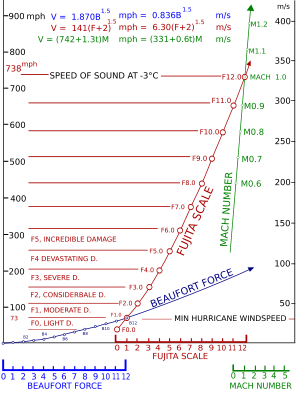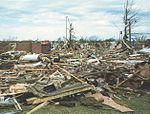사용자:HurricaneRulzMath/FujitaScale
후지타 토네이도 계급 (Fujita scale, F-scale, Fujita-Pearson scale)이란, 토네이도의 강도를 나타내기 위해 테드 후지타가 만든 계급이다. 미국에서는 2007년 2월부터 강화된 후지타 계급을 사용한다.
배경
[편집]이 계급은 시카고 대학의 테드 후지타가 앨렌 피어슨과 같이 만들어 1971년에 처음 소개되었다. 이 등급은 1950년 이후 관측된 모든 토네이도 기록의 강도를 매길 수 있게 되었다. 또한 토네이도 프로젝트의 톰 그라줄리스는 1880년 이후 미국에서 관측된 모든 토네이도의 강도를 매겼다. 원래 그레이트브리튼 섬 외의 대부분 지역에서 이 등급을 사용하였으나, 2007년 미국에서는 강화된 후지타 계급을 사용하게 되었다.
각 피해 단계는 풍속과 관련이 있긴 하나, 후지타 등급은 피해 중심 계급이고, 풍속은 실제 피해와 관련이 없다. 이러한 풍속의 차이로 인해 강화된 후지타 계급이 만들어졌다. 그러나 이 계급의 풍속도 추측한 것으로, 미국의 건물을 중심으로 만든 것이다. However, being determined by expert elicitation with top engineers and meteorologists, the EF scale wind speeds remain as educated guesses, and are also based to United States construction practices.
유래
[편집]
원래 후지타 계급은 보퍼트 풍력 계급과 마하 수 계급을 부드럽게 잇기 위해 13단계(F0~F12)로 구성되어 있었다. F1단계는 보퍼트 계급의 12단계에 해당하는 등급이고, F12단계는 마하 수 1.0에 해당하는 등급이다. F0등급은 거의 피해가 없는 상태를 나타내며, 보퍼트 계급의 8~11단계에 해당한다. 여기서의 풍속을 이용해 후지타 등급의 각 등급에 대한 피해의 질적인 서술을 하였다. [1] 오른쪽 그림은 보퍼트 계급, 후지타 계급, 마하 수 계급의 관계를 나타낸 것이다.
후지타가 이 계급을 만들었을 때, 바람으로 인한 피해에 관한 정보가 많이 없어 원래 등급은 피해에 대한 풍속을 추측해서 정하였다. 후지타는 F5단계까지만 실생활에 쓸 것을 당부했으나 F6단계에 대한 설명을 덭붙이기도 했다. 그는 F6단계 토네이도를 "상상도 할 수 없는 토네이도"라고 설명했다.[2]
Furthermore, the original wind speed numbers have since been found to be higher than the actual wind speeds required to incur the damage described at each category. The error manifests itself to an increasing degree as the category increases, especially in the range of F3 through F5. The National Oceanic and Atmospheric Administration notes that "... precise wind speed numbers are actually guesses and have never been scientifically verified. Different wind speeds may cause similar-looking damage from place to place—even from building to building. Without a thorough engineering analysis of tornado damage in any event, the actual wind speeds needed to cause that damage are unknown."[2] Since then, the Enhanced Fujita Scale has been created using better wind estimates by engineers and meteorologists.
Some sources add level F+", meaning a tornado with winds below 39 mph; on rare occasions tornadoes this weak are observed covering a wide range of path widths and lengths.
계급
[편집]다음은 강도에 따라 6단계로 나타낸 것이다.The six categories are listed here, in order of increasing intensity.
- When the relative frequency of tornadoes is mentioned, it is the relative frequency in the United States. Frequencies of strong tornadoes (F2 or greater) are significantly less elsewhere in the world. Parts of southern Canada, Bangladesh and adjacent areas of eastern India, and possibly a few other areas do have frequent severe tornadoes; however, data are scarce and statistics in these countries have not been studied thoroughly.
- The rating of any given tornado is of the most severe damage to any well-built frame home or comparable level of damage from engineering analysis of other damage.
- The F6 level, although present in Dr. Ted Fujita's original wind scale, was not intended for use, as it was only for example. [2]
| 등급 | 풍속* | 발생 빈도 | 평균 피해 거리 (미터) | 예상 피해[3] | ||
| mph | km/h | |||||
| F0 | 40–72 | 64–116 | 38.9% | 10–50 | 가벼운 피해
굴뚝에 약간의 피해가 있음; 나무가지가 뿌러짐; 약한 나무가 휘어짐; 간판 부서짐 Some damage to chimneys; branches broken off trees; shallow-rooted trees pushed over; sign boards damaged. |
 |
| F1 | 73–112 | 117–180 | 35.6% | 30–150 | 비교적 가벼운 피해.
지붕 표면이 벗겨짐; The lower limit is the beginning of hurricane wind speed; peels surface off roofs; mobile homes pushed off foundations or overturned; moving autos pushed off the roads; attached garages may be destroyed. |
 |
| F2 | 113–157 | 181–253 | 19.4% | 110–250 | 상당한 피해.
Roofs torn off frame houses; mobile homes demolished; boxcars overturned; large trees snapped or uprooted; highrise windows broken and blown in; light-object missiles generated. |
 |
| F3 | 158–206 | 254–332 | 4.9% | 200–500 | 심각한 피해.
Roofs and some walls torn off well-constructed houses; trains overturned; most trees in forest uprooted; skyscrapers twisted and deformed with massive destruction of exteriors; heavy cars lifted off the ground and thrown. |
 |
| F4 | 207–260 | 333–418 | 1.1% | 400–900 | 매우 심각한 피해.
Well-constructed houses leveled; structures with weak foundations blown away some distance; cars thrown and large missiles generated. Skyscrapers and highrises toppled and destroyed. |
 |
| F5 | 261–318 | 419–512 | <0.1% | 1100 ~ | 극심한 피해.
Strong frame houses lifted off foundations and carried considerable distances to disintegrate; automobile sized missiles fly through the air in excess of 100 m (109 yd); trees debarked; steel reinforced concrete structures badly damaged; incredible phenomena will occur. |
 |
*Fujita's initial wind speed estimates have since been found to be highly inaccurate. See Enhanced Fujita Scale
NB: Path widths are averages of tornadoes of their Fujita rating and are approximate values; tornado intensity should not be assumed by the size of the damage path. One F5 tornado had a damage path just 90 meters wide at one point.
Decommission in the US
[편집]The Fujita scale, introduced in 1971 as a means to differentiate tornado intensity and path area, assigned wind speeds to damage that were, at best, educated guesses.[4] Fujita and others recognized this immediately and intensive engineering analysis was conducted through the rest of the 1970s. This research, as well as subsequent research, showed that tornado wind speeds required to inflict the described damage were actually much lower than the F-scale indicated, particularly for the upper categories. Also, although the scale gave general descriptions for the type of damage a tornado could cause, it gave little leeway for strength of construction and other factors that might cause a building to receive higher damage at lower wind speeds. Fujita tried to address these problems somewhat in 1992 with the Modified Fujita Scale,[5] but by then he was semi-retired and the National Weather Service was not in a position for the undertaking of updating to an entirely new scale, so it was a minor step.[6]
In the USA and some other countries, on February 1, 2007, the Fujita scale was decommissioned in favor of what these scientists believe is a more accurate Enhanced Fujita Scale, which replaces it. The EF Scale is thought to improve on the F-scale on many counts—it accounts for different degrees of damage that occur with different types of structures, both man-made and natural. The expanded and refined damage indicators and degrees of damage standardize what was somewhat ambiguous. It also is thought to provide a much better estimate for wind speeds, and sets no upper limit on the wind speeds for the strongest level, EF5. Several countries, including Canada and France, continue to use the original Fujita Scale.
See also
[편집]- Beaufort scale
- Saffir-Simpson Hurricane Scale
- Rohn Emergency Scale for measuring the magnitude (intensity) of any emergency
- Tornado intensity and damage
- List of tornadoes and tornado outbreaks
- List of F5 and EF5 tornadoes
- Severe weather terminology
References
[편집]Notes
[편집]- ↑ Storm Prediction Center Enhanced Fujita Scale (EF Scale)
- ↑ 가 나 다 Tornado FAQ. Storm Prediction Center. Site accessed June 27, 2006.
- ↑ Fujita Tornado Damage Scale Storm Prediction Center. Accessed 2009-05-20.
- ↑ Fujita, Tetsuya Theodore (1971). 《Proposed characterization of tornadoes and hurricanes by area and intensity》. Chicago: University of Chicago.
- ↑ http://www.spc.noaa.gov/MF Scale and EF Scale.
- ↑ Fujita, Tetsuya Theodore (1992). 《Memoirs of an Effort to Unlock the Mystery of Severe Storms》. Chicago: University of Chicago.
Bibliography
[편집]- Marshall, Timothy P. (2001). "Birth of the Fujita Scale". Storm Track. 24 (3): 6–10.
External links
[편집]- NOAA National Weather Service Improves Tornado Rating System (NOAA News)
- Enhanced F Scale for Tornado Damage (SPC)
- The Enhanced Fujita Scale (EF Scale) (SPC)
- Fujita Scale Enhancement Project (Wind Science and Engineering Research Center at Texas Tech University)
- Mitigation Assessment Team Report: Midwest Tornadoes of May 3, 1999 (Federal Emergency Management Agency)
- A Guide to F-Scale Damage Assessment (NWS)
- A Guide for Conducting Convective Windstorm Surveys (NWS SR146)
- The Tornado: An Engineering-Oriented Perspective (NWS SR147)
- The Fujita Scale of Tornado Intensity (The Tornado Project)
